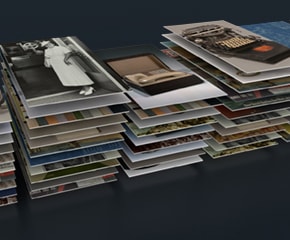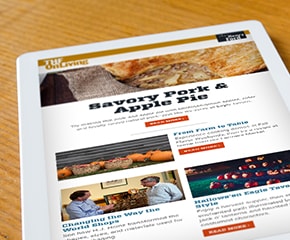
Curating & Preserving
The 1967 Ford Mark IV
All-American Speed
The Ford Mark IV, driven by Dan Gurney and A.J. Foyt, raced into the record books on June 11, 1967, as the first and—to date—only all-American built and operated race car to win the 24 Hours of Le Mans. Designed by Ford engineers and managed at Le Mans by racing legend Carroll Shelby, the Mark IV was a source of national pride. This iconic car represented the power of American engineering.
The Mark IV was crafted for endurance racing. With a 7-liter 500-horsepower Ford V-8 and a chassis of honeycombed aluminum, the Mark IV reached incredible speeds over 200 miles per hour in ‘67. The fourth iteration of Ford’s GT40 race cars, the Mark IV was extensively tested in wind tunnels and refined to create near-perfect aerodynamics.
During the race, Gurney and Foyt took the lead within 90 minutes, and finished the grueling 24-hour event four laps ahead of the second-place Ferrari 330 P4—a sweet victory considering Ford had tried unsuccessfully to purchase Ferrari years earlier. When a deal could not be reached between the two, Ford decided that instead of buying the Italian automaker, they’d have to beat it. And that’s exactly what happened.
Returning from Retirement with a Bumpy Start
In 2012, the Mark IV traveled to Europe to celebrate the 45th anniversary of its Le Mans win. The tour proved taxing on the historic car, though, and it was damaged during transit.
Conserving, Not Restoring
The conservation team here at The Henry Ford is careful to explain the difference between conservation and restoration. Conservation aims to present an artifact as it was when it was used—retaining the original materials and preserving the car’s wear and use. Restoration, however, seeks to make an artifact look as it had when it was new—and ultimately, to erase its history. “At The Henry Ford, we pride ourselves on exhibiting authenticity,” said Matt Anderson, our Curator of Transportation. “We want this car returned to the condition it was in before the 2012 damage, nothing more.”
While The Henry Ford boasts a state-of-the-art conservation laboratory, we needed outside help with the process. We sought consultants with a keen understanding of the car’s significance and the importance of preserving its history. To help us complete the conservation, we ultimately chose none other than Dan Gurney’s All American Racers—the very same Dan Gurney that drove the Mark IV to victory in ’67.
“Dan Gurney and A.J. Foyt made this Mark IV famous with their win at Le Mans,” said The Henry Ford’s executive vice president, Christian Overland. “And to have Dan, his son Justin and their employees take on the job of conserving it for future generations seems so right.”
Freezing a Moment of History
To assess the damage, we called on Mose Nowland, who, during his career with Ford Racing, worked on the car during the 1967 Le Mans race. After examining the car, Nowland noted that the original solenoid, starter and oil filter were still on the engine. Furthermore, the wire ties used to secure cables at the race were still in place. “That’s how we did it at Le Mans that day,” he remarked. “This is all original.” With Noland’s confirmation, we were even more anxious to maintain the original state of the car when performing repairs.
Our conservators trusted that Dan Gurney’s shop would make every effort to preserve the iconic racer’s glory. They were tasked to straighten the car’s frame and engine mounts and to repair a damaged sill on the car’s left side.
All American Racers executed their repairs with utmost precision, using photographs and blueprints to guide them. They made sure to maintain the history of the automobile. For example, in 1967, race team members sat atop the fiberglass frame during a victory lap, causing stress cracks in the body. This damage represents the car’s history and was to remain after conservation.
Disassembly Discovery
Upon disassembly, our team made an interesting discovery. We found that Shelby made last-minute revisions to the car, reshaping the rocker panels with florist’s foam and sheet aluminum, presumably to improve aerodynamics. Perhaps these final alterations sealed the car’s triumphant fate.
Returning Home
After receiving first-class treatment at All American Racers, the Mark IV returned home to The Henry Ford for final repairs. Cracks not present when the car was shipped overseas were filled with carefully mixed and color-matched paint. Rivets replaced by AAR were painted and the “FORD” name was reapplied to the left rocker panel.
Our conservation team debated over whether or not to replace the cracked windshield, as the crack had spidered after 47 years—but we ultimately decided to leave it in place as an important part of the car’s story. We did order a replacement windshield for future use.
Visitors and car enthusiasts can rest assured knowing that our conservation experts have done everything possible to ensure that the Mark IV remains as it was when it took the checkered flag in 1967, becoming a source of national pride in the first and—to date—only all-American victory at Le Mans.
“The car is a perfect survivor of that historic race,” Overland said. “It’s a world treasure.”


